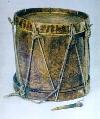INSTRUMENTAL MUSIC |
||||
DRUMS AND DRUM-LIKE INSTRUMENTS (MEMBRANOPHONES) Būgnas a drum, a percussion instrument. The body is the hollowed out trunk of an ash or birch tree. The two membranes are made of dogskin, which is stretched across the drum with wooden or metal pivots. Wooden rings holding the membranes on both ends of the drum are tied together with string. The membrane is tightened as pieces of wood, bone, or other pieces of string are woven between the crisscrossed strings. In Žemaitija, single-membrane drums were also made, and were played with one end of the drum placed on the ground. Such a drum was called a "kelmas", or tree stump. The drum was beaten with one or two sticks. It was used to send signals and to invite people to gatherings. It appeared also in funerals and other ritual traditions. As other musical instruments appeared for dance accompaniment, the drum began to be used also as a musical instrument. Būgnelis - "little drum", smaller than būgnas, with the corpus made of a bent wooden board or veneer. A dogskin or goatskin membrane (sometimes rawhide) is attached to one end. Occasionally two small brass or tin cymbals are strung on a metal wire in openings which are carved into the drum. The būgnelis was beaten either by hand or with a wooden drumstick. They were used as both musical and signal instruments.
|
||||
| PREVIOUS | ||||

